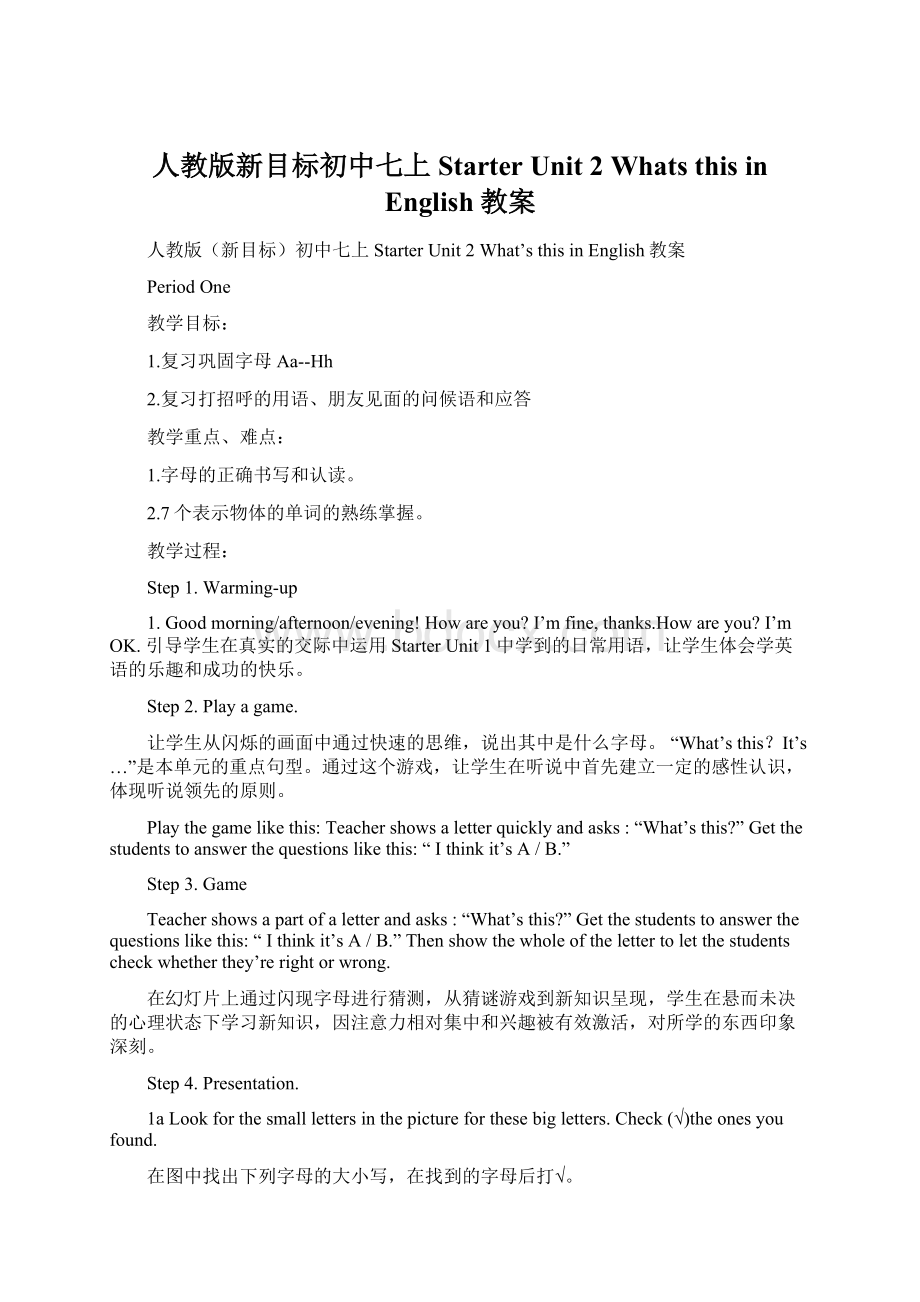人教版新目标初中七上Starter Unit 2 Whats this in English教案.docx
《人教版新目标初中七上Starter Unit 2 Whats this in English教案.docx》由会员分享,可在线阅读,更多相关《人教版新目标初中七上Starter Unit 2 Whats this in English教案.docx(15页珍藏版)》请在冰豆网上搜索。

人教版新目标初中七上StarterUnit2WhatsthisinEnglish教案
人教版(新目标)初中七上StarterUnit2What’sthisinEnglish教案
PeriodOne
教学目标:
1.复习巩固字母Aa--Hh
2.复习打招呼的用语、朋友见面的问候语和应答
教学重点、难点:
1.字母的正确书写和认读。
2.7个表示物体的单词的熟练掌握。
教学过程:
Step1.Warming-up
1.Goodmorning/afternoon/evening!
Howareyou?
I’mfine,thanks.Howareyou?
I’mOK.引导学生在真实的交际中运用StarterUnit1中学到的日常用语,让学生体会学英语的乐趣和成功的快乐。
Step2.Playagame.
让学生从闪烁的画面中通过快速的思维,说出其中是什么字母。
“What’sthis?
It’s…”是本单元的重点句型。
通过这个游戏,让学生在听说中首先建立一定的感性认识,体现听说领先的原则。
Playthegamelikethis:
Teachershowsaletterquicklyandasks:
“What’sthis?
”Getthestudentstoanswerthequestionslikethis:
“Ithinkit’sA/B.”
Step3.Game
Teachershowsapartofaletterandasks:
“What’sthis?
”Getthestudentstoanswerthequestionslikethis:
“Ithinkit’sA/B.”Thenshowthewholeofthelettertoletthestudentscheckwhetherthey’rerightorwrong.
在幻灯片上通过闪现字母进行猜测,从猜谜游戏到新知识呈现,学生在悬而未决的心理状态下学习新知识,因注意力相对集中和兴趣被有效激活,对所学的东西印象深刻。
Step4.Presentation.
1aLookforthesmalllettersinthepictureforthesebigletters.Check(√)theonesyoufound.
在图中找出下列字母的大小写,在找到的字母后打√。
Step5.Workon1b.
播放1b录音,同学们先听。
第二次播放1b录音,同学们跟读,培养学生学习兴趣和良好习惯。
Step6.Workon1c.
同桌练习根据1a练习对话,然后编写对话,老师在教室移动聆听帮助。
并鼓励学生尽可能用自己刚才得到的英语名字进行操练,不会读的可以请教老师。
当然允许他们使用自己的中文名字进行练习。
关键是要鼓励学生大胆开口,愿意说的良好习惯。
Step7.Homework
制作从I到R的卡片,并涂上颜色。
板书设计:
Unit2What’sthisinEnglish?
What’sthis?
Ithinkit’s
课后反思:
人教版(新目标)初中七上StarterUnit2What’sthisinEnglish?
教案
PeriodTwo
教学目标:
1.学习字母Ii–Rr。
2.学习key,pen,map,ruler,orange,quilt,jacket7个词汇
3.学习辨认物体(Identifythings):
What’sthisinEnglish?
It’s....
教学重点、难点:
1.学习字母Ii–Rr以及它们的写法。
教学过程:
Step1.Warming-up
1.Goodmorning/afternoon/evening!
Howareyou?
I’mfine,thanks.Howareyou?
I’mOK.继续巩固StarterUnit1中学到的日常用语,让学生体会学英语的乐趣和成功的快乐。
Step2.Playagame.
Findouttheletters:
Teachershowsthelettersveryquicklygetthestudentstocallouttheletterstheysee.通过游戏的形式复习已学知识,最大程度地调动了学生的有意注意力,在轻松愉快的课堂氛围里,学生的积极性容易被调动,思维容易被激活
Step3.2a
Listenandrepeat.听录音并跟读。
Step4.2b
Listenandnumberthelettersyouhear[1-10].听录音,根据所听到的顺序为字母编号。
Step5.2c
Lookandcopy.观察并抄写下列字母。
在这里注意,要给同学们讲一讲这几个字母的笔顺
Step6.2d
Writethemissingbigletterorsmallletterforeachpair.补全每组所缺的大小写字母。
感受成功的快感。
在展示自我的过程中,学生体验到勇敢、积极、大胆所带来的愉快的心情体验。
Step7.2e
Talkaboutwhattheselettersmean.谈谈下列字母或字母组合的含义。
开放型的任务培养学生的动脑或拓展能力,同时为下一课时作好准备。
Step8.Homework
用英语写下自己卧室的物品名称。
板书设计:
Unit2What’sthisinEnglish?
WhatisthisinEnglish?
Itisa/anmap/orange…
课后反思:
Unit1What’sthematter?
教学目标:
1语言目标:
描述健康问题的词汇,及如何根据别人的健康问题提建议。
2技能目标:
能听懂谈论健康问题的对话材料;能根据别人的健康问题提建议;能写出重
点单词和重点句型,并能描述怎样对待健康问题。
3情感目标:
通过开展扮演病人等活动,培养学生关心他人身体健康的品质。
通过本课的阅读,培养学生处理紧急事件的基本能力,树立紧急事件时互相
帮助的精神。
教学重点:
短语:
haveastomachache,haveacold,liedown,takeone’stemperature,
gotoadoctor,getoff,toone’ssurprise,agreetodosth.,getintotrouble,
falldown,beusedto,runout(of),cutoff,getoutof,beincontrolof,
keepon(doingsth.),giveup
句子:
1What’sthematter?
Ihaveastomachache.Youshouldn’teatsomuchnexttime.
2What’sthematterwithBen?
Hehurthimself.Hehasasoreback.
Heshouldliedownandrest.
3Doyouhaveafever?
Yes,Ido.No,Idon’t.Idon’tknow.
4Doeshehaveatoothache?
Yes,hedoes.
HeshouldseeadentistandgetanX-ray.
5Whatshouldshedo?
Sheshouldtakehertemperature.
6ShouldIputsomemedicineonit?
Yes,youshouldNo,youshouldn’t.
教学难点:
掌握情态动词should\shouldn’t.的用法;学习have的用法。
课时划分:
SectionA11a–2d
SectionA23a-3c
SectionA3GrammarFocus-4c
SectionB11a-2e
SectionB23a-Selfcheck
SectionA1(1a–2d)
Step1Warmingupandnewwords
1.Lookatapictureandlearnthepartsofthebody.
2.Newwordsandphrases.
Step2Presentation
1aLookatthepicture.Writethecorrectletter[a-m]foreachpartofthebody.
___arm___back___ear___eye___foot
___hand___head___leg___mouth
___neck___nose___stomach___tooth
Step3Listening
1bListenandlookatthepicture.Thennumberthenames1-5
Listentotheconversationsagainandfillintheblanks.
Conversation1
Nurse:
What’sthematter,Sarah?
Girl:
I___________.
Conversation2
Nurse:
What’sthematter,David?
Boy:
I_________________.
Conversation3
Nurse:
What’sthematter,Ben?
Boy:
I_________________.
Conversation4
Nurse:
What’sthematter,Nancy?
Girl:
I_________________.
Conversation5
Betty:
What’sthematter,Judy?
Ann:
She__________________.
Step4Speaking
1cLookatthepictures.Whatarethestudents’problems?
Makeconversations.
Examples
A:
What’sthematterwithJudy?
B:
Shetalkedtoomuchyesterdayanddidn’tdrinkenoughwater.
Shehasaverysorethroatnow.
A:
What’sthematterwithSarah?
B:
Shedidn’ttakecareofherselfontheweekend.Shewasplayingwithherfriendsat
theparkyesterday.Thenitgotwindy,butshedidn’tputonherjacket.Nowshehas
acold.
Step5Guessinggames
Guesswhathashappenedtothestudentsbyusingtheimportantsentences.
Step6Listening
2aListenandnumberthepictures[1-5]intheorderyouhearthem.
2bListenagain.Matchtheproblemswiththeadvice.
Step7Speaking
2cMakeconversationsusingtheinformationin2aand2b
A:
What’sthematter?
B:
Myheadfeelsveryhot.
A:
Maybeyouhaveafever.
B:
WhatshouldIdo?
A:
Youshouldtakeyourtemperature.
Step8Role–play
Imagineyouaretheschooldoctor.Afewstudentshavehealthproblems.Role-playa
conversationbetweenthedoctorandthestudents.
2dRole–playtheconversation
Step9Languagepointsandsummary
1.What’sthematter?
这是人们特别是医生和护士询问病人病情时最常用的问句,意思是“怎么了?
”其后通
常与介词with连用。
类似的问句还有:
What’swrong?
怎么啦?
What’swrongwithyou?
你怎么了?
What’syourtrouble?
你怎么了?
What’sthetroublewithyou?
你怎么了?
What’sup?
你怎么了?
2.haveacold伤风,感冒,是固定词组,表示身体不适的常用词组还有:
haveabadcold重感冒
haveafever发烧
haveaheadache头痛
haveastomachache肚子痛,胃痛
haveatoothache牙痛
Summary:
1.牙疼haveatoothache
2.胃疼haveastomachache
3.背疼haveabackache
4.头疼haveaheadache
5.喉咙疼haveasorethroat
6.发烧haveafever
7.感冒haveacold
8.躺下并且休息liedownandrest
9.喝热蜂蜜茶drinkhotteawithhoney
10.喝大量水drinklotsofwater
11.看牙医seeadentist
12.量体温takeone’stemperature
13.看医生gotoadoctor
Step10Exercises
根据上下文意思填空。
Mandy:
Lisa,areyouOK?
Lisa:
I_____aheadacheandIcan’tmovemyneck.What______Ido?
ShouldI
_____mytemperature?
Mandy:
No,itdoesn’tsoundlikeyouhaveafever.What_____youdoonthe
weekend?
Lisa:
Iplayedcomputer_____allweekend.
Mandy:
That’sprobablywhy.Youneedtotakebreaks_____fromthecomputer.
Lisa:
Yeah,IthinkIsatinthe_____wayfortoolongwithoutmoving.
Mandy:
Ithinkyoushould____downandrest.Ifyourheadandneckstillhurttomorrow,then
gotoa_______.
Lisa:
OK.Thanks,Mandy.
翻译下列句子:
1.你怎么了?
我头痛。
2.他怎么了?
他发烧
3.李雷怎么了?
他喉咙痛。
他应该多喝水。
4.如果你的头和脖子明天仍然疼的话,请去看医生。
Homework:
Makeupaconversationbetweenadoctorandapatient.
SectionA2(3a–3c)
Step1Presentation
Lookatthepicture.Discusswhathappenedandthenwhatweshoulddo.
Teacher:
Whathappenedinthepicture.
Students:
Teacher:
Whatshouldwedotohelpthem?
Students:
Teacher:
Didthebusdriverhelpthem?
Students:
Step2Reading
3aReadthepassageandanswerthefollowingquestions.
Doyouthinkitcomesfromanewspaperorabook?
Howdoyouknow?
Didthebusdriverhelpthemanandthewoman?
3bReadthepassageagainandcheckthethingsthathappenedinthestory.
1____WangPingwasthedriverofbusNo.26at9:
00a.m.yesterday.
2____BusNo.26hitanoldmanonZhonghuaRoad.
3____Theoldmanhadaheartproblemandneededtogotothehospital
rightaway.
4____Thepassagersonthebusdidnotwanttogotothehospital,soonly
WangPingwentwiththewomanandoldman.
5____Somepassagershelpedtogettheoldmanontothebus.
6____Theoldmangottothehospitalintime.
Step3Speaking
3cDiscussthequestionswithapartner.
Step4Languagespoints
1....whenthedriversawanoldmanlyingonthesideoftheroad.
......这时司机看到一位老人正躺在路边。
观察与思考:
你能看出“看到某人正在做某事”的句型吗?
seesb.doingsth.看见某人正在做某事
e.g.WhenIpassthewindowIseehimdrawingapicture.
seesb.dosth.看见某人做过某事
e.g.Ioftenseehimdrawapicture.
活学活用:
1)我看见他时他正在河边玩。
Isawhim_______bytheriver.
2)我看见过他在河边玩。
Isawhim_____bytheriver.
3)我看着他过了桥。
Iseehim______acrossthebridge.
4)我看见她正在洗碗。
Iseeher_________thedishes.
2.Thebusdriver,24-year-oldWangPing,stoppedthebuswithoutthinkingtwice.
3.Heonlythoughtaboutsavingalife.
观察与思考:
你能看出“withoutthinking”、“aboutsavingalife”的共同点吗?
共同点:
介词+doing;介词+名词、宾格代词、doing
活学活用:
用适当的形式填空。
1)Iamfine.Whatabout____(she)?
2)Thanksfor______(tell)methestory?
3)Itisasunnyday.Howabout_____(go)fishing?
4)Itisgoodtorelaxby______(use)theInternetor_________(watch)gameshows.
4.Buttohissurprise,theyallagreedtogowithhim.
toone’ssurprise
使......惊讶的是,出乎......意料
e.g.Totheirsurprise,allthestudentspasstheexam.
Muchtoeveryone’ssurprise,theplansucceeded.
5....becausetheydon’twantanytrouble,...
当trouble意为“困难;麻烦”时,是不可数名词。
如:
I’msorrytogiveyousomuchtrouble.
(1)beintrouble意为“有困难;陷入困境”。
如:
Healwaysasksmeforhelpwhenheisintrouble.
(2)getsb.intotrouble意为“使某人陷入困境”。
如:
Ifyoucome,youmaygetmeintotrouble.
(3)主语+have/hastrouble(in)doingsth.意为“某人在做某事方面有困难”。
如:
Ihavesometrouble(in)readingtheletter.
当trouble意为“麻烦事;烦心事”时,是可数名词。
如:
Shewasonthephoneforanhourtellingmehertroubles.
【运用】根据汉语意思完成英语句子,每空词数不限。
(1)他认为每天吃饭是一件麻烦事。
Hethinksthateatingeverydayis_________.
(2)你知道你现在为什么处于困境吗?
Doyouknowwhyyou_____________now?
(3)我妹